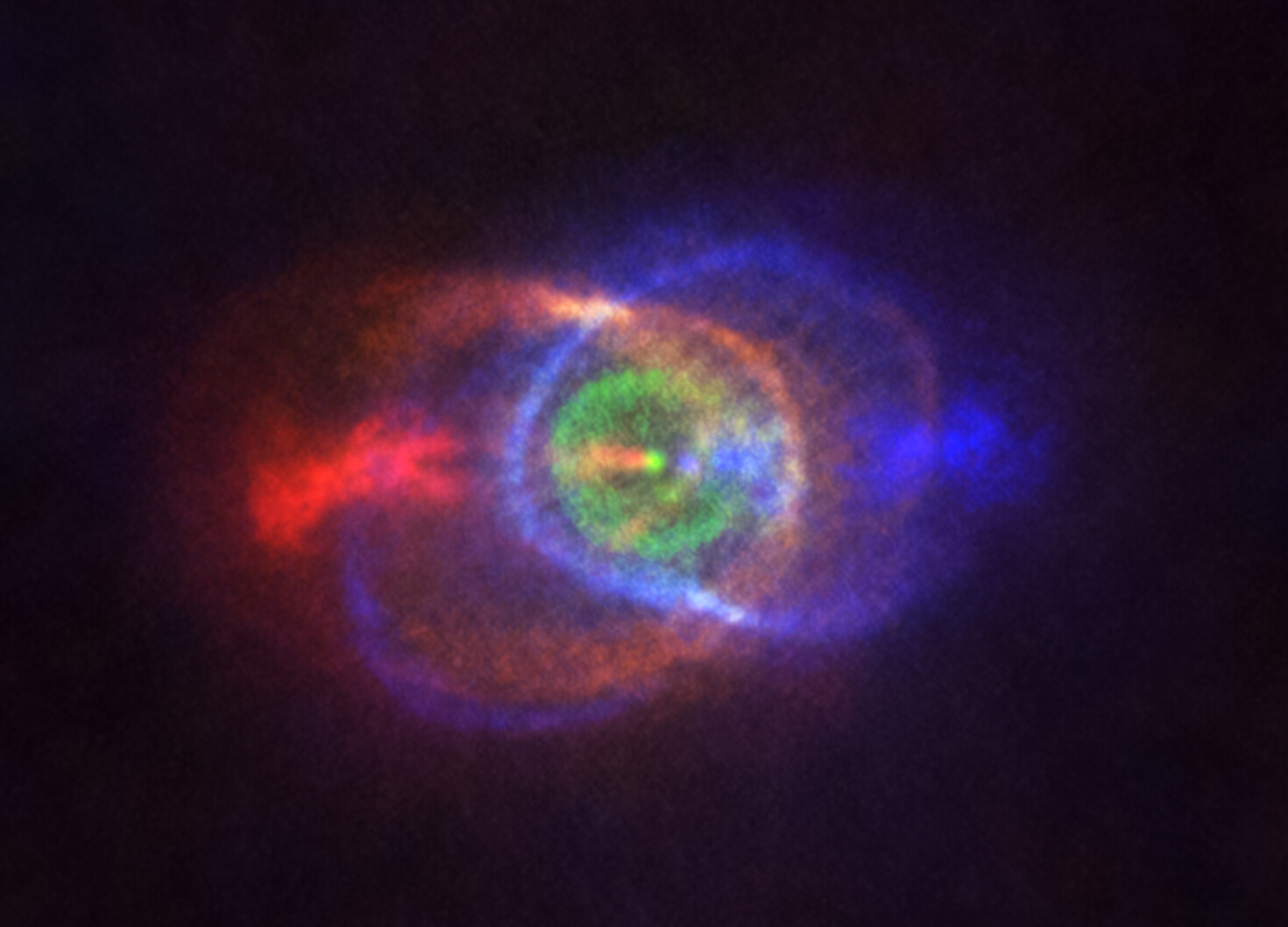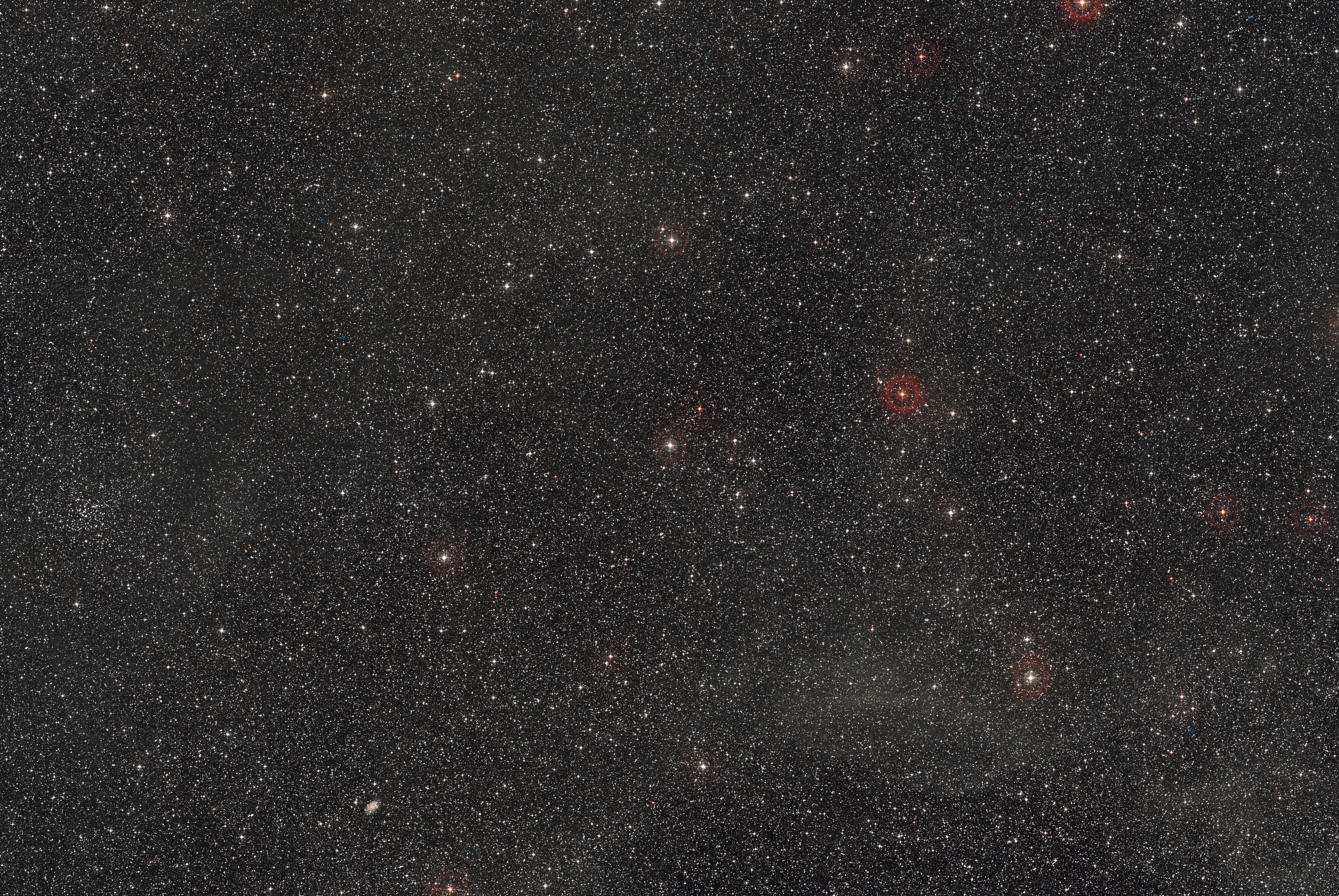Spectacular rainbow cloud in space spawned by cosmic showdown between stars
The red giant star engulfed its smaller stellar companion
A stunning rainbow-colored cloud of gas surrounds a pair of stars that duked it out a few hundred years ago.
Using the Atacama Large Millimeter/submillimeter Array (ALMA), astronomers observed the binary star system called HD101584, revealing a peculiar gas cloud that is believed to be the result of a confrontation between the two stars, according to a statement from the European Southern Observatory.
Data from ALMA and the Atacama Pathfinder EXperiment (APEX) shows that one of the stars grew so large that it engulfed the other. As the smaller star spiraled towards its giant stellar companion, it caused the larger, sun-like star to shed its outer layers, resulting in the expanding clouds of gas captured in the newly released ALMA images.
Related: These weirdo stellar corpses have creamy centers filled with exotic quantum liquids
Typically, when sun-like stars burn through all the hydrogen at their core, they become a bright red-giant star. When this type of star dies, it sheds its outer layers, leaving behind a hot, dense remnant called a white dwarf.
However, the evolution of the red giant in HD101584 "was terminated prematurely and dramatically as a nearby low-mass companion star was engulfed by the giant," Hans Olofsson, an astronomer at the Chalmers University of Technology in Sweden who led new research on the star pair, said in the statement.

As the smaller star spiraled toward its larger companion, jets of gas formed, which, in turn, propelled the material ejected from the red giant out into space. This process formed the rings of gas and the bright blue and red blobs of material seen in the ALMA images. The blue clouds of gas represent the material moving the fastest toward us, while the red clouds of gas represent the material moving the fastest away from us, according to the statement.
Get the Space.com Newsletter
Breaking space news, the latest updates on rocket launches, skywatching events and more!
Based on the ALMA observations, the researchers suggest the low-mass companion star was captured by the red giant star when it reached a critical size only a few hundred years ago, according to the statement.

The smaller star spiraled in towards the red giant, but stopped before reaching its core, which is why the pair appears so close together and is represented as a single bright dot at the center of ALMA image.
"Currently, we can describe the death processes common to many sun-like stars, but we cannot explain why or exactly how they happen," a Sofia Ramstedt, co-author on the new research and an astronomer at Uppsala University in Sweden, said in the statement. "HD101584 gives us important clues to solve this puzzle since it is currently in a short transitional phase between better studied evolutionary stages. With detailed images of the environment of HD101584 we can make the connection between the giant star it was before, and the stellar remnant it will soon become."
Their findings were published last year in the journal Astronomy & Astrophysics.
- In a rare sighting, astronomers observe burst of activity as a massive star forms
- Milky Way glitters over ALMA radio telescope in stunning photo
- Meet ALMA: Amazing photos from giant radio telescope
Follow Samantha Mathewson @Sam_Ashley13. Follow us on Twitter @Spacedotcom and on Facebook.
Join our Space Forums to keep talking space on the latest missions, night sky and more! And if you have a news tip, correction or comment, let us know at: community@space.com.

Samantha Mathewson joined Space.com as an intern in the summer of 2016. She received a B.A. in Journalism and Environmental Science at the University of New Haven, in Connecticut. Previously, her work has been published in Nature World News. When not writing or reading about science, Samantha enjoys traveling to new places and taking photos! You can follow her on Twitter @Sam_Ashley13.
-
swiggly This is going into my lecture on astrophotography next week as an example of what not to do in a science article that features a false color image. 95% of the public will think these are real colors in the nebula as you would see it with your eyes. Nowhere in the article (unless I missed it) is it mentioned that these are not real color, but false or "representative color" and the headline reinforces this misconception. To well informed folks this would be obvious since it is a mm wave radio image but most of the public will not know that.Reply -
Etherair It seems like the red jet is the one coming towards us. Hard to tell from this image but possibly a typo got inserted some where along the chain of possession? Many photos of jet pairs show the jet coming towards the viewer much more clearly that the jet retreating into the distance. A single misunderstanding and the incoming jet was colored red instead of blue and vice versa. Grammar is good and spelling is fine so it passes the proofreading.Reply
Or it could be my tired eyes. -
swiggly Missed the point entirely. The article did not make clear that these are not the actual colors of the object. They HAVE NO actual colors as we know them since it is a radio image. The inexperienced reader is led to believe this is a "rainbow" object which has no meaning for a radio image since the colors are assigned arbitrarily to the radio wavelengths.. This is WAY too common in astronomy journalism and something the average general public reader does not know. Do not assume they do.Reply









